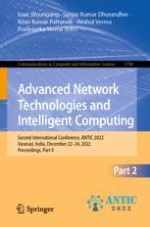2023 | Buch
Advanced Network Technologies and Intelligent Computing
Second International Conference, ANTIC 2022, Varanasi, India, December 22–24, 2022, Proceedings, Part II
herausgegeben von: Isaac Woungang, Sanjay Kumar Dhurandher, Kiran Kumar Pattanaik, Anshul Verma, Pradeepika Verma
Verlag: Springer Nature Switzerland
Buchreihe : Communications in Computer and Information Science
